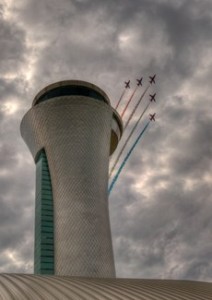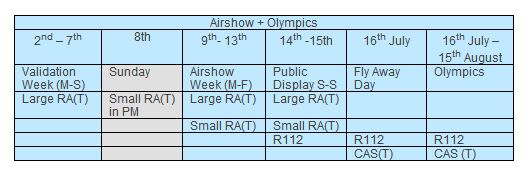Farnborough Airshow
Posted by flysynergy on May 3, 2012 in GA News | Comments Off on Farnborough Airshow While understandably most people’s focus this summer will be on the Olympics and its associated airspace restrictions and changes, the UK is also hosting the world’s biggest trade airshow, which has its own airspace changes and restrictions. Although the organisers moved the date to deconflict with the Olympics, the security airspace does overlap with the show and then runs consecutively into the temporary CAS supporting the Games.
While understandably most people’s focus this summer will be on the Olympics and its associated airspace restrictions and changes, the UK is also hosting the world’s biggest trade airshow, which has its own airspace changes and restrictions. Although the organisers moved the date to deconflict with the Olympics, the security airspace does overlap with the show and then runs consecutively into the temporary CAS supporting the Games.
The Important Part
From 1 July onwards be sure to keep a close eye on the NOTAMs. These will indicate the periods of time when the Temporary Restricted Airspace RA(T) that is being put in place to protect Farnborough airshow traffic will be active.
This airspace will either take the form of the 'Small RA(T)' or the 'Large RA(T)'. The smaller restriction is designed to protect the arrivals and departure of airshow traffic with the larger airspace reserved for the flying displays themselves. Graphical charts depicting these two RA(T)s can be found by clicking on the links above. These are currently draft versions until published in Statutory Instrument.

The Finer Details
So, what will be in place at Farnborough? ATC briefs as follows:
Firstly, on 2 July, the airshow validation week (2 July – 7 July) starts. Every aircraft flying as part of the show must demonstrate their displays, including good weather (High) and bad weather (Low) versions, and the transition between the two, in front of a rigorous approval committee called the Flying Control Committee. Pilots must prove they can fly their selected display safely and that the displays are suitable for the difficult flying restrictions imposed by the geography of Farnborough, the neighbouring airfields and the presence of large amounts of permanent Class A controlled airspace. If they fail any element they will be either asked to modify the routine, demonstrate it again or have their invitation to display revoked.
This process is obviously extremely important and to protect the operation a Restricted Airspace (Temporary) RA (T) will be put in place, but the WOD-OCK corridor is opened to allow GA transit access, subject to ATC workload. The nature of validation means that inadvertent infringement of the airspace will normally involve stopping the display. With over 50 aircraft required to demonstrate over 100 displays, the effects can be catastrophic for timetabling even to the extent of cancelling parts of the display. So we really need people to be briefed and alert if you are operating in this area. We will allow transits where able but this is time critical. Also, please watch out for the temporary holds to the south and north of Farnborough that the aircraft waiting for validation will be using.
We take a breather on 7 July but keep a simple version of the large RA (T) to allow stragglers to validate if allowed – and on 8 July the airspace changes, for the first time, into the ‘small’ RA (T) for the afternoon. This is to protect the final arrivals for the static display – normally the very large commercial airliners.
On 9 July, the show starts with the airspace alternating between ‘small’ and ‘large’ RA (T)’s. The small RA (T) protects the very large number of aircraft that have to arrive/depart outside of show time, the helicopters (600+ movements in the first four days), and the demonstration flights. The large RA (T) protects the displays themselves and these gradually get longer over the week, culminating in the public displays, of over four hours, at the weekend.
Then it gets more complicated. On the 14th July the RA (T)s get incorporated into the Olympics security Restricted Zone (R112) and all the regulations associated with that need to be observed. Be careful how you flight plan if you want to transit the airspace – the WOD/OCK corridor will still be open but transits through the large RA (T) may be difficult. The main heliport closes for the weekend, but there are over 600 helicopter pleasure flights in the show area each day —
Coinciding with the introduction of the Olympics temporary controlled airspace is Fly Away Day on the 16th July, where all the static and flying display aircraft are required to depart unless they have special permission to stay. This means 150 departures on top of our normal 150 aircraft movements. Farnborough ATC have chosen to have a CTR/A the same shape as the RA (T), primarily because local pilots are used to flying with these restrictions. So, on the 16th July, the ‘small’ RA (T) morphs seamlessly into CAS (T), still surrounded by the Olympics Restricted Zone (R112), but now with further Olympics CAS (T) to the west. We have tried to keep the latter as simple as possible in terms of bases – 2,500ft and 3,500ft in the west and following existing airspace boundaries so ground landmarks are still useable.
Farnborough LARS West will still operate, but LARS North and East will be closed until the 16th August. This area will be controlled by the Military controllers providing the Atlas air traffic control service in the Restricted Zone (R112) using the Farnborough radio frequencies. London FIS is still available as well as Southampton, Odiham, Benson and Brize Norton.

Please be careful and plan fully using NOTAMS, AICs and other services such as SkyDemon Light. It is even more crucial this year especially the timing of the ‘small/large’ RA (T)s, and the crucial change periods for the transition to the Olympics.
Source: www.olympics.airspacesafety.com
